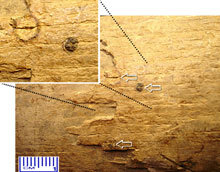A team led by Richard Firestone, a nuclear scientist at the Lawrence Berkeley National Laboratory in Berkeley, Calif., made the discovery while testing thousands of samples of fossilized Alaskan mammoth ivory from a suspected meteor impact that occurred about 13,000 years ago.

|
| ©R. Firestone |
"You would see round circles with little holes in them," Firestone told CBC News in an interview Thursday, referring to hundreds of circular burn marks he saw on some mastadon tusks.
X-ray analysis showed tiny rock fragments deep inside those holes, and metallurgical tests confirmed the fragments did come from meteors.
Firestone said he believes meteorites exploded over parts of Beringia - the Ice Age-era region that includes parts of modern-day Alaska, Yukon and Siberia - creating showers of fragments, or "micrometeorites," that struck and killed many of the prehistoric creatures that roamed the area.
Furthermore, Firestone's team uncovered a surprise: The sample tusks dated back to about 35,000 years ago, meaning they were older than the blast from 13,000 years ago that they were initially studying.
"It turns out that there was an impact event, probably a meteor, that exploded over Alaska and probably over Siberia ... around that time and embedded these particles into the tusks," he said.
"They probably came in under very high velocities, hundreds of kilometres a second almost. It must have exploded and just embedded these things in the tusks in large quantities, as many as 100 or more in one tusk."
The small holes with meteorite fragments were found in about one out of every 1,000 pieces of mastodon ivory pieces Firestone's team has tested. They also found similar fragments in one Siberian bison skull that appeared to have survived the blast, he said.
"In the bison skull, since that was bone, we could see renewed growth around these particles after they had been impacted. So presumably the bison - that particular individual, at least - survived the impact."
Now, Firestone is asking Yukoners for any mammoth fossil samples they may have. He is asking anyone who has found fossilized bone or ivory with circular discolorations to try and collect soil samples in the area where they found the fossil, then contact him at the California laboratory.
"We think they came from your area around the Yukon somewhere," he said. "So presumably [Yukoners] are going to be finding these things if they look for them."
Firestone's findings were presented last month at a meeting of the American Geophysical Union in San Francisco.



Reader Comments
to our Newsletter